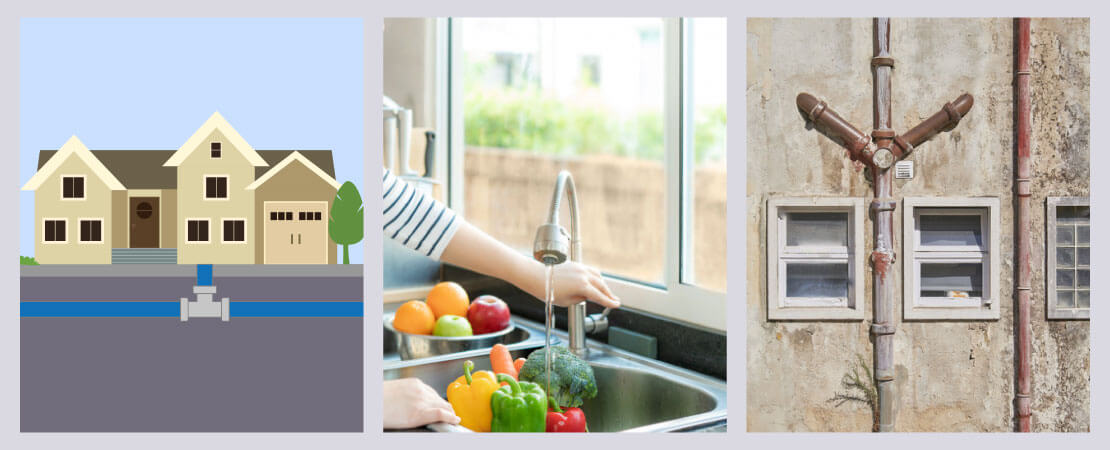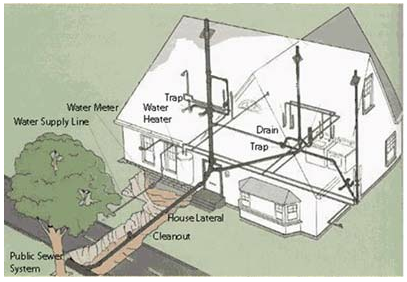The Anatomy of Your Home's Plumbing System Explained
The Anatomy of Your Home's Plumbing System Explained
Blog Article
What are your thoughts on The Inner Workings of Your Home's Plumbing?

Recognizing exactly how your home's plumbing system works is important for each homeowner. From delivering tidy water for drinking, cooking, and bathing to securely removing wastewater, a well-kept plumbing system is important for your household's wellness and convenience. In this extensive overview, we'll check out the complex network that composes your home's pipes and offer ideas on upkeep, upgrades, and managing typical problems.
Introduction
Your home's plumbing system is more than just a network of pipes; it's a complex system that guarantees you have accessibility to tidy water and effective wastewater removal. Understanding its elements and how they work together can aid you stop expensive repair work and guarantee whatever runs efficiently.
Fundamental Elements of a Pipes System
Pipelines and Tubes
At the heart of your pipes system are the pipes and tubes that lug water throughout your home. These can be constructed from numerous materials such as copper, PVC, or PEX, each with its advantages in regards to durability and cost-effectiveness.
Components: Sinks, Toilets, Showers, and so on.
Components like sinks, bathrooms, showers, and bathtubs are where water is used in your house. Understanding exactly how these components attach to the plumbing system assists in detecting issues and planning upgrades.
Shutoffs and Shut-off Points
Shutoffs control the flow of water in your plumbing system. Shut-off valves are important during emergencies or when you require to make repair work, enabling you to isolate parts of the system without disrupting water circulation to the whole home.
Water Supply System
Key Water Line
The major water line attaches your home to the community water system or a personal well. It's where water enters your home and is distributed to numerous fixtures.
Water Meter and Pressure Regulatory Authority
The water meter procedures your water use, while a pressure regulatory authority makes certain that water flows at a secure stress throughout your home's plumbing system, stopping damages to pipes and fixtures.
Cold Water vs. Hot Water Lines
Recognizing the difference between cold water lines, which supply water straight from the major, and warm water lines, which lug heated water from the water heater, assists in repairing and planning for upgrades.
Drain System
Drain Pipes Pipes and Traps
Drain pipes bring wastewater far from sinks, showers, and commodes to the sewer or sewage-disposal tank. Catches prevent drain gases from entering your home and likewise catch particles that could cause obstructions.
Air flow Pipelines
Ventilation pipes allow air into the drain system, preventing suction that could slow drain and trigger catches to vacant. Correct ventilation is important for keeping the stability of your plumbing system.
Importance of Correct Drain
Making certain correct water drainage prevents back-ups and water damages. On a regular basis cleansing drains pipes and keeping catches can stop pricey fixings and extend the life of your plumbing system.
Water Heating System
Types of Hot Water Heater
Hot water heater can be tankless or standard tank-style. Tankless heating systems heat water as needed, while containers save warmed water for instant use.
How Water Heaters Connect to the Plumbing System
Understanding just how hot water heater link to both the cold water supply and hot water distribution lines helps in diagnosing concerns like not enough warm water or leaks.
Maintenance Tips for Water Heaters
Regularly flushing your hot water heater to eliminate sediment, checking the temperature level setups, and examining for leaks can expand its lifespan and improve power effectiveness.
Common Pipes Issues
Leakages and Their Causes
Leakages can happen as a result of aging pipes, loosened fittings, or high water pressure. Addressing leakages immediately avoids water damage and mold development.
Blockages and Blockages
Obstructions in drains pipes and toilets are often caused by purging non-flushable items or a buildup of oil and hair. Utilizing drain displays and being mindful of what drops your drains can protect against blockages.
Signs of Pipes Problems to Watch For
Low tide pressure, slow-moving drains, foul odors, or unusually high water expenses are signs of possible plumbing troubles that should be resolved quickly.
Pipes Maintenance Tips
Normal Evaluations and Checks
Schedule yearly plumbing examinations to catch concerns early. Seek signs of leakages, deterioration, or mineral buildup in taps and showerheads.
DIY Maintenance Tasks
Simple tasks like cleansing faucet aerators, checking for commode leakages using color tablets, or protecting revealed pipes in chilly environments can protect against significant pipes issues.
When to Call an Expert Plumber
Know when a pipes issue requires expert know-how. Trying complicated fixings without correct knowledge can bring about even more damages and greater fixing prices.
Upgrading Your Plumbing System
Factors for Updating
Updating to water-efficient fixtures or replacing old pipes can improve water top quality, minimize water bills, and raise the worth of your home.
Modern Pipes Technologies and Their Benefits
Explore technologies like clever leakage detectors, water-saving commodes, and energy-efficient water heaters that can conserve money and decrease ecological impact.
Cost Factors To Consider and ROI
Calculate the in advance expenses versus long-lasting financial savings when taking into consideration pipes upgrades. Many upgrades pay for themselves with minimized utility expenses and fewer repair work.
Environmental Influence and Preservation
Water-Saving Components and Devices
Setting up low-flow taps, showerheads, and toilets can dramatically decrease water usage without compromising performance.
Tips for Decreasing Water Usage
Simple behaviors like repairing leaks immediately, taking shorter showers, and running full loads of laundry and meals can save water and lower your energy costs.
Eco-Friendly Plumbing Options
Consider sustainable plumbing products like bamboo for floor covering, which is durable and environment-friendly, or recycled glass for counter tops.
Emergency Preparedness
Actions to Take Throughout a Pipes Emergency
Know where your shut-off shutoffs lie and exactly how to turn off the water in case of a ruptured pipeline or major leakage.
Value of Having Emergency Contacts Helpful
Keep get in touch with information for neighborhood plumbing technicians or emergency solutions easily offered for fast reaction during a pipes crisis.
Do It Yourself Emergency Fixes (When Applicable).
Momentary repairs like using air duct tape to patch a dripping pipe or positioning a bucket under a dripping tap can minimize damages until a specialist plumbing gets here.
Verdict.
Understanding the anatomy of your home's pipes system encourages you to preserve it properly, saving money and time on repair services. By following routine upkeep routines and staying notified regarding modern plumbing modern technologies, you can ensure your plumbing system runs effectively for several years ahead.
Exploring Your Homes Plumbing Anatomy
Water Supply System
Main Water Line: This is where water enters your home from the municipal supply or a private well.
Water Meter: Typically located near where the main water line enters the property, it measures the amount of water used.
Shutoff Valve: It s crucial to know where this is in case of emergencies. It allows you to turn off the water supply to the entire house.
Pipes and Fittings: These distribute water throughout your home. Materials can include copper, PVC, or PEX.
Drain-Waste-Vent (DWV) System
Drains: Located in sinks, showers, and tubs, these carry wastewater away.
Traps: U-shaped pipes under sinks that hold standing water, blocking sewer gases from entering the home.
Vents: Pipes that lead from the DWV system to the outside, preventing vacuum formation and allowing gases to escape.
Sewer Line: Carries all wastewater from the home to the municipal sewer system or a septic tank.
Fixtures and Appliances
Sinks, Toilets, and Showers
Dishwashers and Washing Machines
Water Heaters
Maintenance Tips
Regularly check for leaks in exposed pipes and around fixtures.
Inspect the water heater annually for signs of wear.
Clean drains and traps to prevent clogs and odors.
Know how to shut off water to individual fixtures.
When to Call a Professional
Major leaks or burst pipes
Installation of new pipes or fixtures
Septic tank issues
Remodeling projects that involve plumbing changes
Conclusion
Understanding the anatomy of your home's plumbing is key to maintaining a functional and efficient system. Regular checks and knowing when to call in the experts can save you time, money, and stress.
https://www.mavyn.com/blog/exploring-your-homes-plumbing-anatomy

Exploring Your Homes Plumbing Anatomy
Water Supply System
Drain-Waste-Vent (DWV) System
Fixtures and Appliances
Maintenance Tips
When to Call a Professional
Conclusion
Understanding the anatomy of your home's plumbing is key to maintaining a functional and efficient system. Regular checks and knowing when to call in the experts can save you time, money, and stress.
https://www.mavyn.com/blog/exploring-your-homes-plumbing-anatomy
I'm very curious about Understanding Your Home's Plumbing Anatomy and I really hope you enjoyed the post. Sharing is nice. Helping others is fun. We truly appreciate your readership.
Automated Marketing Report this page